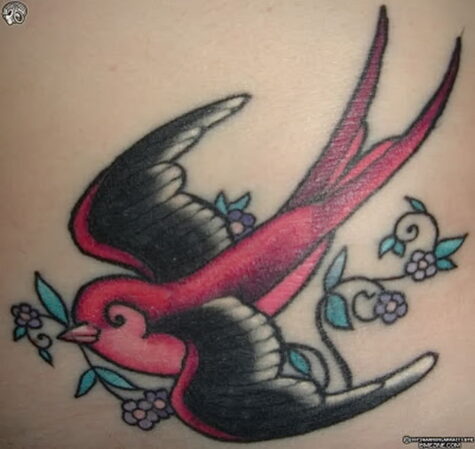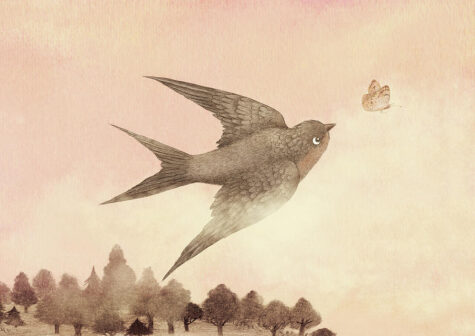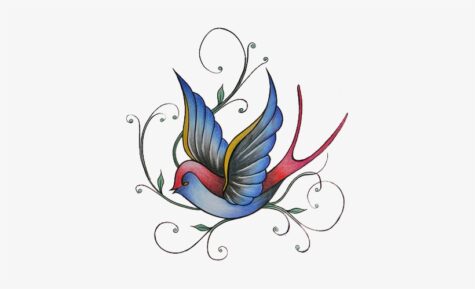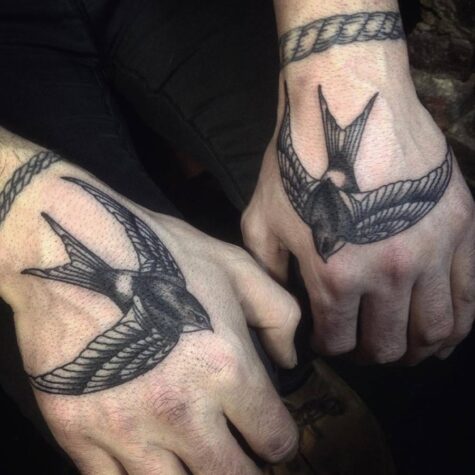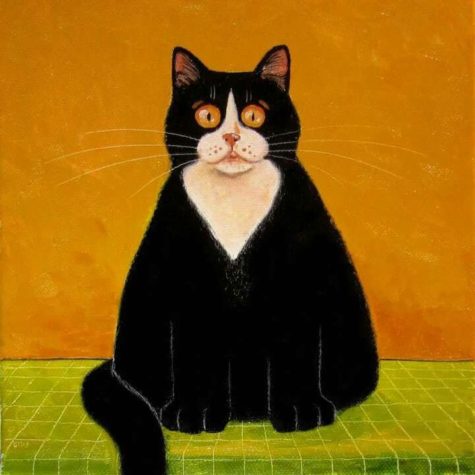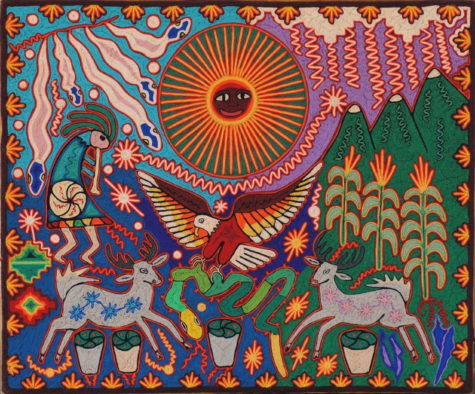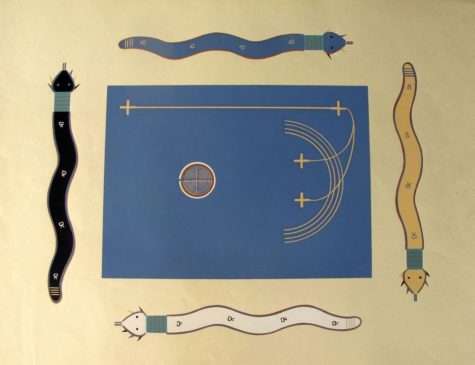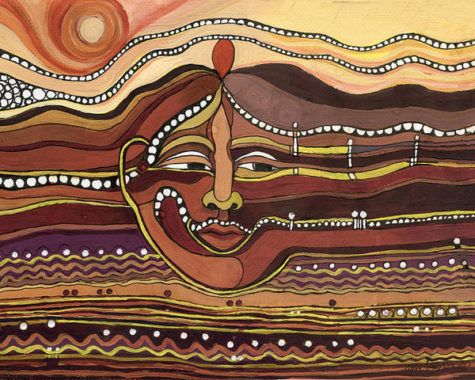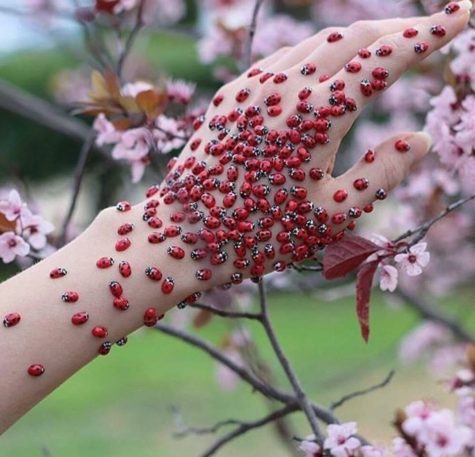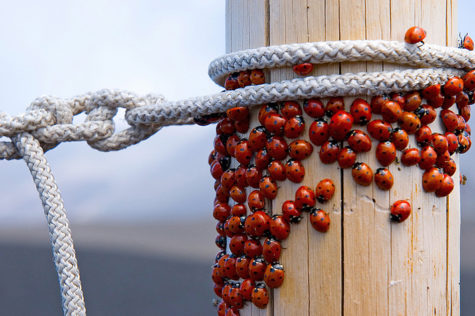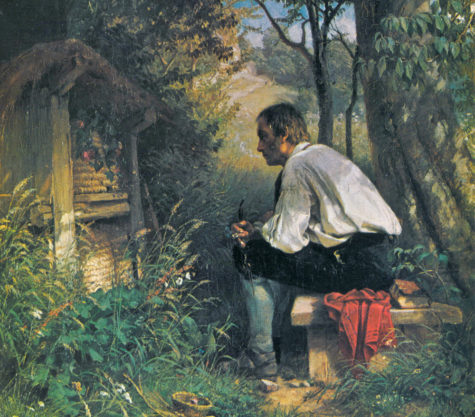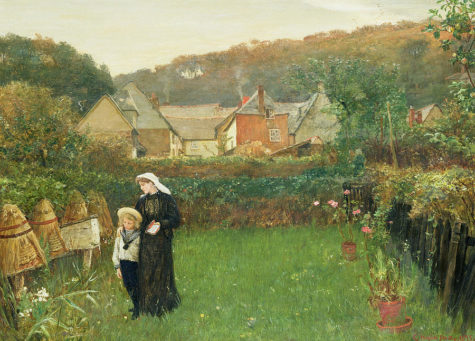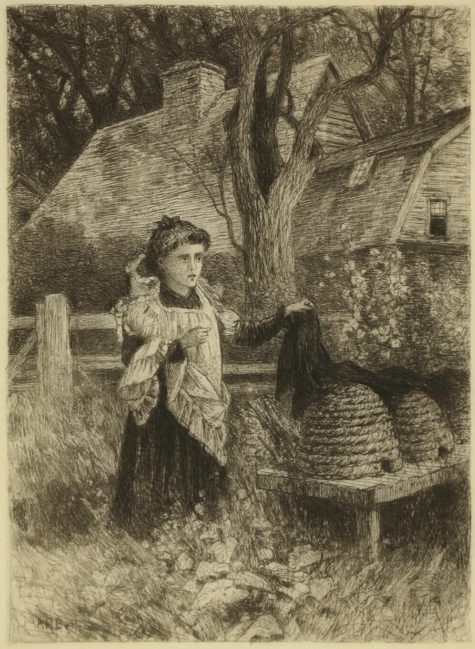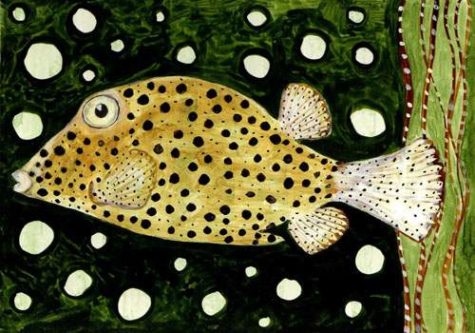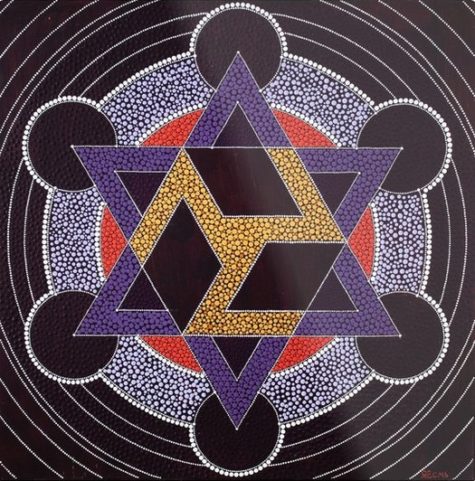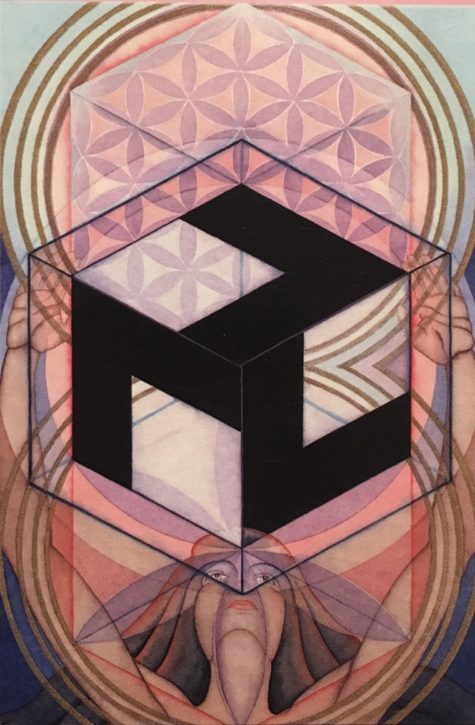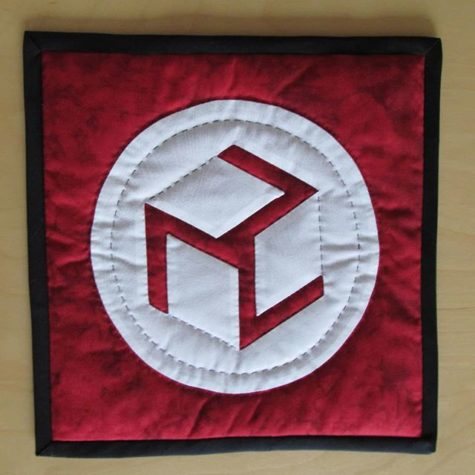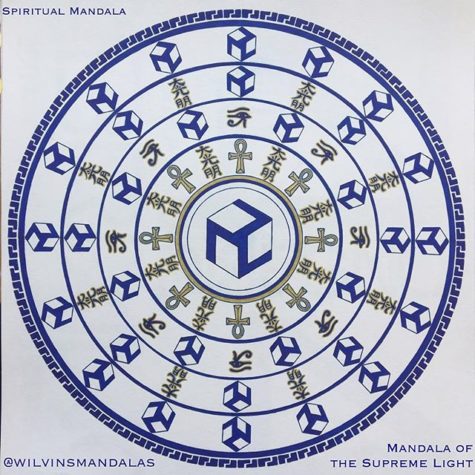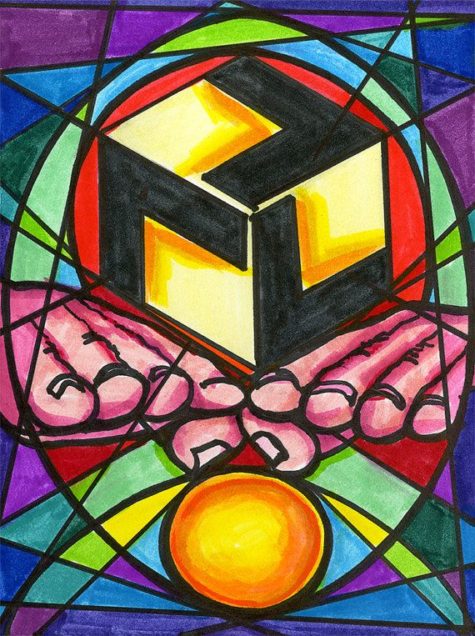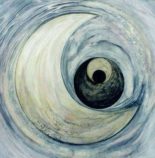The Swallow Tattoo
Having a swallow tattoo is a creative way of expressing yourself. If you are going to get one, you may want to understand what it means first. The symbolism of the swallow tattoo is cause for controversy and confusion.
Possessing a swallow tattoo symbol used to be a sign of status among sailors. The meaning behind it was that swallows, supposedly, protected the sailors from harm on their journeys.
However, a similar version of the story is that, if the sailors did die at sea, the swallow would protect their soul and carry them to heaven. Either way, the meaning is similar. It was a great comfort, as well as a status symbol, to sailors out at sea.
According to legend, after sailing for at least five thousand miles, a sailor could get a swallow tattoo symbol put on his chest, to mark the occasion. This gave him a great sense of honor and achievement. A longer version of the legend is that, when he had traveled over ten thousand miles, he was entitled to get a second swallow tattoo on the other side of his chest.
Getting a second tattoo gave sailors an enormous sense of pride and accomplishment. It also served as a sort of pictorial resume. Since traveling by ship was very dangerous during that time. Thus, it was a sign of an experienced sailor who could be counted on in a crisis.
Sailors with two swallow tattoo symbols on their chests, instead of one, were especially sought after. It meant that they had weathered many storms and gotten through many challenges. Therefore, any captain looking for new crew members was always happy to see a sailor with two swallow tattoos on his chest.
Here is one story of the origin of the swallow tattoo: there was a ship named the swallow, the men had a mutiny and the original seven mutineers had swallows tattooed on them so that they could identify each other. Out of this, two things happened:
- The authorities heard of this identification and searched for the seven sailors who got swallows.
- Their friends got swallows tattooed on them and lied about being one of the original seven to throw the authorities off the right trail.
To a sailor the swallow means a “safe return home”. Seeing a swallow is the “first sign that land is near.” Swallows are known to travel far distances out to sea during migration and would rest on boats close to shore which gave early mariners the first sign that land was indeed close by. The horizon is 12 miles from a boater’s standpoint in the ocean (more if higher up) and swallows fly further then 12 miles out.
The swallow is also known as a sparrow and was worn by the famous pirate “Jack Sparrows”. The story also goes that if a sailor with a swallow tattoo drowns; the swallows come down and lift his soul to the heavens.
The swallow is a noble bird, with a rich history. It is a symbol of honor, faith, love and hope. To sailors in olden days, it represented everything from luck to loyalty. It served as a reminder of family, friendship and honor. In modern times, the sparrow has come to have many, sometimes quite different, meanings when worn as a tattoo. Here are some of them:
- Swallow tattoos are associated with loyalty and fidelity – swallows choose a mate for life and will only nest with that bird and no other.
- They carry a message of hope, when sailors saw a swallow they knew that land was near.
- Freedom.
- It’s a symbol of good luck for adventurers and travelers who will always find their way home. The swallows return home to San Juan Capistrano every year. So the tattoos were used to say that you will always come home.
- They are a sign of loyalty and pride.
- The swallow tattoo is a sign of enduring life, love and hope. It represents enduring courage and happiness.
There also seems to be a small connection to music. Some people connected swallows with a love, respect and appreciation for music. Much like the swallows always returning to San Juan, their home. The tattoo can represent always being home when you’re within the music.
Here is what one person shared about his grandfather’s swallow tattoos:
“I grew up in a bad area in Australia and a grandfather of a friend of mine came from England. He was a very hard man and the whole family was very tough and underworld related. I remember being a kid in their house when the grandfather was there and I asked him what his tattoos meant. He looked down on me with a hard face and said in a thick English accent (they moved to Australia in the 70’s) “It means I can walk into any pub and put my hands on the bar and if anyone would want to fight, then I would fight them”.
He was a big guy and I had heard rumors of him tearing people apart. So I guess that they kind of mean courage, strength and loyalty. Oh yeah he was also a “Teddy Boy” in England, but I am not so sure what that is.”
Depending on where you grew up, and the places you hang out, swallow tattoos can also mean:
- “Live long and live hard”.
- Swallows on the back of the hands are supposed to give you faster hands, such as in a fight or at work.
- The swallow tattoo in England means “these fists fly”.
- If they’re on the backs of the hands, it means you’ll be faster and stronger in a fight. it’s mostly in Great Britain and Australia though.
- In terms of jail house tattoos, the bluebirds, swallows or sparrows can stand for white supremacy or white power.
- In Great Britain, the swallow tattoo on your hands means you’ve earned your ‘wings’ in a UK prison, i.e. you have been initiated into male-male sex rituals.
- Swallow tattoos on a man’s hands and neck originated in British prisons from the term ‘jail-bird’. They indicate that you’ve gone to prison and done your ‘bird’.
- In Scotland it usually signifies a spell in the infamous Bar-L or Barlinnie prison in Glasgow.
The swallow’s wings are so long that the bird never reaches the ground. It always flies high above everything else on earth. Prisoners are known to tattoo themselves with a swallow when they leave prison as a symbol of freedom.
Source: Gypsy Magic
32 Superstitions About Cats
- When you see a one-eyed cat, spit on your thumb, stamp it in the palm of your hand, and make a wish. The wish will come true.
- A kitten born in May is a witches cat.
- A black cat seen from behind – a bad omen
- A black cat crossing your path – good luck.
- A black cat crossing one’s path by moonlight means death in an epidemic. (Irish superstition)
- A strange black cat on your porch brings prosperity. (Scottish superstition)
- English schoolchildren believe seeing a white cat on the way to school is sure to bring trouble. To avert bad luck, they must either spit, or turn around completely and make the sign of the cross.
- In the USA, Spain and Belgium a white cat crossing your path was considered to be good luck.
- To see a white cat on the road is lucky.
- It is bad luck to see a white cat at night.
- Dreaming of white cat means good luck.
- Stray tortoise shell cat – bad omen
- In Normandy, seeing a tortoiseshell foretells death by accident.
- Cats bought with money will never be good mousers
- It is bad luck to cross a stream carrying a cat. (French superstition)
- Cat sneezing once means rain
- Cat sneezing three times – the family will catch a cold
- A cat sneezing is a good omen for everyone who hears it. (Italian superstition)
- In the early 16th century, a visitor to an English home would always kiss the family cat.
- A cat washing on the doorstep means the clergy will visit
- If a cat washes behind its ears, it will rain. (English superstition).
- When the pupil of a cat’s eye broadens, there will be rain. (Welsh superstition)
- A cat sleeping with all four paws tucked under means cold weather ahead. (English superstition)
- In the Netherlands, cats were not allowed in rooms where private family discussions were going on. The Dutch believed that cats would definitely spread gossips around the town.
- If cats desert a house, illness will always reign there. (English superstition)
- In 16th century Italy, it was believed that if a black cat lay on the bed of a sick man, he would die. But there’s also a belief that a cat will not remain in the house where someone is about to die. Therefore, if the family cat refuses to stay indoors, it was an omen of death in the family.
- When moving to a new home, always put the cat through the window instead of the door, so that it will not leave.
- A cat on top of a tombstone meant certainly that the soul of the departed buried was possessed by the devil.
- Two cats seen fighting near a dying person, or on the grave shortly after a funeral, are really the Devil and an Angel fighting for possession of that person’s soul.
- If you kick a cat you will get Rheumatism.
- To kill a cat brings seventeen years of bad luck. (Irish superstition)
- Killing a cat is an absolute guarantee that you have sacrificed your soul to the Devil.
Collected from various sources
Navajo Superstitions About Animals
Only a few wild animals or birds are considered friendly to the Navajos. Owls, crows, mice, and coyotes are considered helpers of the witches and evil spirits. When the monsters were seeking the infant Hero Twins, the owls, crow, mice, and coyotes spied for them. Cottontail rabbits are also associated with witches.
Antlers from elk and deer are not used. Mountain sheep horn, buffalo parts, and antelope horn are used in rituals and ceremonies. Navajos can use mountain lion skin and a few feathers. The eagle’s feather is the most important feather that is used by the Navajos. Most feathers from other birds are prohibited. All water animals can be found in Navajo taboos. Snakes are associated with lightning and rain.
- Do not kill frogs, lizards, salamanders, and toads because it will rain and keep on raining, result in a flood, ruin your crops, you will jump around, you will become crippled, it will effect you unborn child, or it will cause paralysis and other diseases.
- Do not kill horned toads because they are grandfathers or guardians of arrowheads. If you kill one you will get a stomachache, or swell up, or have a heart attack.
- Do not watch a frog eat or you will have throat problems later and trouble swallowing.
- Do not kill a spider unless you draw a circle around it and say, ” you have no relatives.” Or “a Zuni did it.” If you don’t its relatives will come and bite you. If you blame the Zunis, the angry spiders will go and bite them instead of coming after you.
- Do not urinate on an anthill because you will have trouble going to the bathroom.
- Do not burn ants because red spots will cover your body or you will get a rash.
- Do not burn bees because you will have a rash.
- Do not throw stinkbugs in the fire or you will get a rash or sores.
- Do not kill grasshoppers because it will give you a nosebleed.
- Do not bother baby hawks or eagles because you will get a rash or sores on your body.
- Do not kill moths or you will jump in a fire.
- Do not count the number of legs on a centipede or the number you count will be the number of years that you have left to live.
- Do not kill a bald headed insect and spider or you will go bald.
- Never carry or handle feathers from ravens, crows, owls, buzzards, or most any bird because you will get boils. (Since it is difficult to know the source of many feathers it is best to leave all alone!)
- Do not kill porcupines or you will get nosebleeds.
- Do not spit on a spider rock or you will not be able to breathe right.
- Do not put food in a bird’s mouth or you will get a sore throat.
- Do not kill a lizard or you will get skinny.
- Do not burn any animal skin or you will get a rash.
- Do not urinate on a deerskin or you will clog up.
While bear claws are commonly warned for their talisman’s power by almost all Native Americans, Navajos avoid any parts of the bear. Some of the taboos associated with bears are probably due to their rather human appearance when they are standing straight up. Bears are also the main figure in an important Navajo ceremony, the Mountain Way. The bear taboos have a common theme. If a human being mimics a wild animal, he will become like that animal. In the case of bears, the taboo is more powerful because of the human-like resemblance of the bears. Also, because bears are one of the were animals associated with witchcraft.
- Do not step on a bear’s waste because it will bother you or act like a bear.
- Do not make fun of a bear or it will make you sick.
- Do not step on rocks turned over by a bear or bears will chase you.
- Do not walk over a bear track because you will get hairy, you can not get off the track, or you will act crazy.
- Do not walk on a bear track or you will turn into a skinwalker.
- Do not say “Shush” (bear) in the mountains because bears will come after you.
- Do not laugh at bears or they will come after you.
Since their introduction, cattle sheep, and horses have always been important to the economy and lifestyle of the Navajo. Large herds of mustangs roam the Navajo reservation and eat the grass that could have been used for sheep and cattle.. However, the Navajos do not consider these animals worthless and they will not consider the disposal of some of these animals. Navajo take good care of their livestock. There was a time in the history of the Navajo that a man’s wealth was measured by how many horses he owned. The Navajos were well known across the Southwest due to their excellent horsemanship skills.
- Do not say bad things about your livestock or something bad will happen to them.
- Do not kill a sheep or goat that is unusual, or has three horns, or is of both sexes. They are good luck and you will lose your flock if one of these animals were killed.
- Do not count your sheep to much or you flock will get smaller.
- Do not clap at sheep because things will happen to them and you will have a small herd.
- Never put a sheep’s head on the ground upright or it will go away and you will lose your herd.
- Do not play with a ball when you are herding sheep or your lambs will be born deformed.
- Do not throw things at the sheep or they will disappear.
- Do not ride on a sheep’s back or as punishment you will be hurt.
- Do not waste any part of the animal after butchering or your flock will be less.
- Do not burn livestock manure because you are burning the animals too.
- Do not kill to many sheep at the same time because the herd will not like it. They will disappear and run away.
- Do not burn wool because your sheep will be poor and something will happen to them.
- Do not play with the horns of a goat because one will bother you and it is bad luck for the herd.
- Do not twist goats’ tails because they might come off. You will have bad luck.
- Do not go to sleep while you are herding sheep because a crow might take your eyes out.
- Do not say, “I wish I had some meat” when you have the hiccups or your livestock won’t grow.
- Do not cut the tips off of a horses ears off or earmark the ears because he will become stupid and hard to manage.
- Do not burn horsehair because you will lose your horses.
- Do not ride a pregnant animal or make it work hard because it will lose the baby and never give birth again.
- Do not watch a horse or other animals give birth or you will go blind.
- Do not cut a horse’s tail because it will fall of a cliff.
- Do not leave deer blood where sheep can walk on it or all the wool will fall out.
- Do not let your sheep or yourself walk on a deerskin or they will go crazy and run away.
- Do not spit on anyone because you will owe him a white stallion.
- Do not eat livestock killed by coyotes or other will animals because you will go crazy and act wild.
- Do not put a rug over the head of a horse because he will go blind.
- Do not buy a dog or cat for a pet or you will get poor.
- Do not open the eyes of newborn kittens or puppies because you will go blind.
- Do not kill dogs because they belong to the spirits and you will become paralyzed.
- Do not brand a dog as a joke or you will lose your livestock.
- Do not choke a kitten or you will have throat trouble.
- Do not watch a dog mate or you will go blind.
- Do not watch a dog go to the bathroom or you will go crazy.
- Do not give food from a ceremony to the dogs because it will spoil the ceremony.
- Do not let a dog bite the Medicine man because the sing will not work.
- Do not talk to dogs or other animals because they might talk back and you will die.
- Do not let a dog eat in front of you when you butcher or you will lose the meat.
Source: Navajo Central
Navajo Snake Superstitions
Poisonous snakes on Navajo land were a real threat to the Navajo and their livestock. The snake is also a symbol of the lightning people and brings rain to the dry land. While the only significant venomous snakes present are the rattlesnakes, all snakes are avoided. Snakes are seen in Navajo sand paintings and other artworks.
- Do not cross a snake’s path unless you slide or shuffle your feet because you will have leg aches, other diseases, or bad luck.
- Do not eat in front of a snake because when you get older your throat will close.
- Do not watch a snake swallow its food or your neck will swell up.
- Do not open your mouth when you see a snake or he will jump in.
- Do not kill snakes or lizards because it will make your heart swell, it will dry up, or you will get crooked teeth.
- Do not burn a snake because you will get sores or a rash.
- Do not kill a snake when it is raining or lightning will strike your house.
- Do not put a snake in the open when it is dead because lightning will bring it back to life.
- Do not put a dead snake on a rock or you will cause a thunderstorm and it will come back to life.
- Snakes are an earthly manifestation of the Lightning People and related to the Thunders.
- They are in communication with the supernatural world. If dead snakes are exposed to the sky, it will draw the attention of the Serpent Spirits.
- Killing snakes for the no reason will drive away the life giving rains and cause a drought.
- Do not kill a snake with your hand or your hand will swell up.
- Do not pick up things between two fingers because only snakes do that.
- Do not step on a snake because your legs will swell up or get crooked.
- Do not watch snakes mating or you will go blind.
- Do not draw in the sand with your fingers or snakes will come to it.
- Do not talk about snakes or they will come around.
- Do not laugh at a snake or it will bite you.
- Do not make faces at a snake or it will bite you some day.
- Do not spit at a snake or it will come after you.
- Do not watch a snake crawl out of its skin because you will get sick or jump out of your skin.
- Do not shoot an arrow at a snake. It will shoot crooked and hit something else.
- Do not run over s snake in your car or you will have a bad life.
- Do not snake eggs or the snakes will get you.
- Do not wear anything made out of snakeskin, especially boots or shoes or you will get crippled.
- Do not touch a snake because it has nothing and you will have nothing.
- Do not call a person a snake or one will be bite you.
Source: Navajo Central
Navajo Superstitions and Taboos
Here is a nice little collection of Navajo beliefs, superstitions, and taboos regarding the natural world and the weather.
- Do not look at clouds moving in the sky. If you do, you will be a slow runner.
- Do not eat when there is an eclipse, or you will have a swollen stomach or stomach problems.
- Do not sleep during an eclipse because your eyes won’t open again.
- Do not look at an eclipse, or you will go blind. This taboo is a fact. People can go blind by looking too long at an eclipse.
- Do not start a fire with a magnifying glass, or you will have a burning in your stomach.
- It is taboo to stand on high rocks. If traditional Navajos do, they say that the rocks will grow into the sky with them.
- Do not roll a rock from a mountain. The holy people put them there and it will be bad luck.
- The monsters that throw people off cliffs, are said to inhabit high places so they are best avoided!
- Do not use partly burned wood because it might be from a lightning struck tree. If you do it will cause illness or bad luck.
- Do not stand up when there is lightning. If you sit down it will go away.
- Do not yell when it is raining or you will be struck by lightning.
- Do not have a dog or cat in the hogan during a storm because it will draw lightning.
- Do not look lightning in the mirror because it will strike your hogan.
- Do not kill a nighthawk or you will be struck by lightning.
- Do not use aspen wood for a fire because it causes thunder and lightning.
- Do not stand by the loom when it is raining because the lightning will strike you.
- Do not weave when it is storming or it will cause lightning. This depends on the pattern being designed on the loom.
- Do not climb a tree when it is raining because lighting might strike the tree.
- Do not lean against a wall during a storm or the lightning will strike you.
- Do not ride a horse during a storm or you will be struck by lightning.
- Do not touch metal objects when it is raining because you will be struck by lightning.
- Do not wash your hair when it is raining because you will be struck by lightning.
- Do not eat an animal killed by lightning because you will be struck by lightning or get sick.
- Do not play around a lightning struck tree because you will get sick.
- Do not call the thunder’s name or the lightning will get you.
- Do not do a rain dance during a rainstorm because you will be struck by lightning.
- Do not lay facing the sky in a storm or the lightning will strike you.
- Do not eat corn when it is raining because lightning will strike you.
- Do not stare at the moon, or it will follow you.
- Don’t point at a rainbow with your finger. The rainbow will cut it off or break it.
- Do not watch a river flowing swiftly, or you will get dizzy and fall in.
- Don’t catch snow when its is falling, or it will keep falling and turn into deep snow.
- Do not hold out their hands when it is snowing because where your hand is will be how deep the snow will be.
- If you eat the first snow, you will become sick.
- Do not shake a flour sack in the winter, or the snow will get big and cause blizzards.
- Do not look at a shooting star unless you blow at it, or you will have trouble and bad luck.
- If you look at a falling star, there will be bad luck.
- Blindness is the punishment of looking to long at the sun. This punishment is a fact on life for all people.
- Don’t whistle too loud, or whistle for four days in a row. If you do, they say you will be calling up the wind
- Don’t throw rocks at a whirlwind. It will throw them back and chase you.
- Don’t call whirlwinds a name. Evil Spirits will get you.
- Don’t go into a whirlwind. It will effect your heart and carry you off.
- Dust devils are an evil wind that blows no one any good. They are animated by evil spirits.
- Don’t whistle or you will call up the wind!
Source: Navajo Central
Ladybird Ladybird Fly Away Home
This traditional verse relates to ladybirds, brightly colored insects commonly viewed as lucky. We’ve all heard this rhyme. There are dozens of different variations. But what does it mean?
The name ladybird contains a reference to Mary, mother of Jesus, often referred to as Our Lady. It is possibly connected with a story that after prayers for help Our Lady brought Ladybird beetle to destroy a plague of plant-destroying pests. According to other lore, farmers recite the rhyme to save the insects who do them this service before setting fire to stubble fields.
The English version has been dated to at least 1744. The verse has several popular forms, including:
Ladybird, ladybird fly away home,
Your house is on fire and your children are gone,
All except one, and her name is Ann,
And she hid under the baking pan.
A shorter, grimmer version concludes:
Your house is on fire,
Your children shall burn!
Among children, it is common to place the ladybird on their hand or blow it from their clothing and make a wish while reciting the rhyme. My favorite variation is this one, written early in the 19th century:
Lady-bird, Lady-bird, fly away home,
The field mouse is gone to her nest,
The daisies have shut up their sleepy red eyes
And the birds and the bees are at rest
Because of the religious connotation, one speculation would date the rhyme back to the 16th century and have it sung as a warning at a time when there was legislation against Catholics.
More variations include the following:
Ladybird, ladybird, fly away home,
Your horse is on foot, your children are gone;
All but one, and that’s little John,
And he lies under the grindle stone.
Dowdy-cow, dowdy-cow, ride away heame,
Thy house is burnt, and thy bairns are tean.
Marybug, fly away,
your house is on fire,
your wee mother weeps
Sky-winger, fly away,
your house is in flames,
your children together in tears
This info came from wikipedia. You can find an infographic with the different varieties of ladybird insects at Totally Random, and some nice ladybug pictures at Way Cool Pictures.
If you are interested in Ladybugs, you can check out this detailed post about Ladybug Totems and Guides, and a crazy Ladybug Toothache Cure.
Telling The Bees
There was a time when almost every rural British family who kept bees followed a strange tradition. Whenever there was a death in the family, someone had to go out to the hives and tell the bees of the terrible loss that had befallen the family. Failing to do so often resulted in further loss such as the bees leaving the hive, or not producing enough honey or even dying.
Traditionally, the bees were kept abreast of not only deaths but all important family matters including births, marriages, and long absence due to journeys. If the bees were not told, all sorts of calamities were thought to happen. This peculiar custom is known as “telling the bees”.
Humans have always had a special connection with bees. In medieval Europe, bees were highly prized for their honey and wax. Honey was used as food, to make mead—possibly the world’s oldest fermented beverage—and as medicine to treat burns, cough, indigestion and other ailments. Candles made from beeswax burned brighter, longer and cleaner than other wax candles.
Bees were often kept at monasteries and manor houses, where they were tended with the greatest respect and considered part of the family or community. It was considered rude, for example, to quarrel in front of bees.
The practice of telling the bees may have its origins in Celtic mythology that held that bees were the link between our world and the spirit world. So if you had any message that you wished to pass to someone who was dead, all you had to do was tell the bees and they would pass along the message. Telling the bees was widely reported from all around England, and also from many places across Europe. Eventually, the tradition made their way across the Atlantic and into North America.
The typical way to tell the bees was for the head of the household, or “goodwife of the house” to go out to the hives, knock gently to get the attention of the bees, and then softly murmur in a doleful tune the solemn news. Little rhymes developed over the centuries specific to a particular region. In Nottinghamshire, the wife of the dead was heard singing quietly in front of the hive:
“The master’s dead, but don’t you go;
Your mistress will be a good mistress to you.”
In Germany, a similar couplet was heard:
”Little bee, our lord is dead;
Leave me not in my distress”.
Telling the bees was common in New England. The 19th century American poet John Greenleaf Whittier describes this peculiar custom in his 1858 poem “Telling the bees”.
Before them, under the garden wall,
Forward and back,
Went drearily singing the chore-girl small,
Draping each hive with a shred of black.
Trembling, I listened: the summer sun
Had the chill of snow;
For I knew she was telling the bees of one
Gone on the journey we all must go!
And the song she was singing ever since
In my ear sounds on:—
“Stay at home, pretty bees, fly not hence!
Mistress Mary is dead and gone!”
In case of deaths, the beekeeper also wrapped the top of the hive with a piece of black fabric or crepe. If there was a wedding in the family, the hives were decorated and pieces of cake left outside so that the bees too could partake in the festivities. Newly-wed couples introduced themselves to the bees of the house, otherwise their married life was bound to be miserable.
If the bees were not “put into mourning”, terrible misfortunes befell the family and to the person who bought the hive. Victorian biologist, Margaret Warner Morley, in her book The Honey-Makers (1899), cites a case in Norfolk where a man purchased a hive of bees that had belonged to a man who had died. The previous owner had failed to put the bees into mourning when their master died, causing the bees to fall sick. When the new owner draped the hive with a black cloth, the bees regained their health.
In another tale, an Oxfordshire family had seventeen hives when their keeper died. Because nobody told them about the death, every bee died. There are plenty of such tales in Morley’s book.
The intimate relationship between bees and their keepers have led to all sorts of folklore. According to one it was bad luck to buy or sell hives, because when you sell one, you sell your luck with your bees. Instead, bees were bartered for or given as gifts. If bees flew into a house, a stranger would soon call. If they rested on a roof, good luck was on its way.
But the relationship between bees and humans goes beyond superstition. It’s a fact, that bees help humans survive. 70 of the top 100 crop species that feed 90% of the human population rely on bees for pollination. Without them, these plants would cease to exist and with it all animals that eat those plants. This can have a cascading effect that would ripple catastrophically up the food chain. Losing a beehive is much more worse than losing a supply of honey. The consequences are life threatening. The act of telling the bees emphasizes this deep connection humans share with the insect.
Source: Amusing Planet
50 Fishy Superstitions
Here is a nice collection of folklore and superstitions about fish:
- A certain bone in the head of a fish will bring good luck, if kept on your person.
- An empty fish tank means bad luck financially.
- When a pet fish dies, something bad was deflected from the owner or household.
- To ensure good luck and safety, a fish should always be eaten from the head toward the tail.
- It’s a bad sign to get married when the fish aren’t biting.
- Throw back the first fish you catch then you’ll be lucky the whole day fishing.
- If you count the number of fish you caught, you will catch no more that day.
- Sometimes fish fall during a rain.
- It’s bad luck to say the word “pig” while fishing at sea.
- To dream of fish means someone is going to have a baby.
- In Japan, all fish are considered lucky, as the word for fish, “yu” is pronounced the same as the word for bounty or surplus.
- A crawfish pinching one of your toes will not let loose until it thunders.
- There is a precious stone in the head of a crawfish.
- Carry on your person the precious stone from the head of a crawfish and you will have good luck.
- Carrying a carp fish charm brings good luck, especially to lovers.
- Carrying the dried eye of a cod will bring good luck.
- Koi fish bring fame and riches.
- If you have goldfish in the house, you will be ailing all the time until you get them out.
- If you blow your breath into a goldfish jar, the fish will die.
- Having a painting of a gold fish is just as lucky as having an actual fish.
- It causes bad luck to keep goldfish in the house.
- Never let anyone give you a goldfish or you will have bad luck.
- Eat snappers and groupers, you will live a long time.
- If you say the entire word “plecostomus” outloud, your Pleco will die.
- It’s bad luck to step on a catfish.
- A giant wriggling catfish makes earthquakes.
- Do not count the crabs until all are collected or it is bad luck on the uncollected pots.
- Keep a piece of oyster shell in your pocketbook for luck and money.
- Minnows come by spontaneous generation.
- If the Arowana jumps out of the tank and dies, it means it saved you or your family from a bad omen.
- The bone in the head of a white perch is especially lucky, if carried by a fisherman.
- When Sharks are following a ship, especially three sharks, it’s a death omen.
- Wearing an eelskin garter cures cramps.
- Rubbing a wart with eels’ blood makes it go away.
- A live eel in a drink cures a person from drunkenness.
- Witches and sorcerers wearing eelskin jackets protects them from bullets.
- A cooked eel will become raw if left uneaten.
- A whole eel can be used to cure deafness.
- Eel fat will render fairies visible to humans
- Eating an eel heart gives you the power of prophecy
- Eating a whole eel will strike you dumb.
- It’s bad luck to burn a haddock.
- Shedding blood near where herring frequent causes the herring to desert the area.
- Laying a salted herring at your feet will relieve a sore throat.
- Suspending a herring from the ceiling on Good Friday will keep your house free from flies during the summer.
- Eating tench makes you strong and wise and can cure illness.
- Other freshwater fish rub themselves against tench when they are sick.
- Putting a trout’s head into a patient’s mouth cures whooping cough.
- Drinking beer in which a trout has been drowned cures whooping cough.
- Drinking milk in which a live trout has been made to swim cures whooping cough.
Note: This post was put together by Shirley Twofeathers, and a lot of work went into it, you may repost and share it only if you give me credit and a link back to this website. Blessed be.
The Flower Omens of Spring
The day you find the first flower of the season can be used as an omen:
- Monday means good fortune.
- Tuesday means greatest attempts will be successful.
- Wednesday means marriage.
- Thursday means warning of small profits.
- Friday means wealth.
- Saturday means misfortune.
- Sunday means excellent luck for weeks.
The Antahkarana
Alice Bailey and several other authors of Tibetan philosophy have some knowledge of the Antahkarana which you can find in a number of books. They describe the Antahkarana as a part of spiritual anatomy. It is the connection between the physical brain and the Higher Self. It is this connection that must heal and develop if we are to grow spiritually. The Antahkarana symbol depicted and described here represents this connection and activates it whenever you are in its presence.
The science of Radionics indicates that lines drawn on paper create a psychic effect on the space surrounding the drawing and will influence the human aura and chakras in various ways depending on the pattern created. This validates the age-old practice of yantra meditation which makes use of visual images to purify and evolve the consciousness.
The Antahkarana is an ancient healing and meditation symbol that has been used in Tibet and China for thousands of years. It is a powerful symbol and simply by having it in your presence, it will create a positive affect on the chakras and aura.
When doing healing work, it focuses and deepens the actions of the healing energies involved. When meditating with the symbol on your person or close by, it automatically creates what the Taoists call the great microcosmic orbit wherein spiritual energies travel up the spine, over the crown chakra, then down through the front of the body to the root chakra and back up again continuously moving around and around. This action balances the chakras and prevents too much energy building up in one or more chakras.
The Anthakarana symbol will also neutralize negative energy that has collected in objects such as jewelry or crystals simply by placing the object between two symbols. In addition, it will enhance all healing work including Reiki, Mahikari, Jin Shin, Polarity Therapy, Chiropractic, Hypnotherapy, and Past Life Regression. These positive effects have been confirmed over and over by the improved results noted by those using the symbol and by clairvoyant observation by those trained in sensing changes in the aura and chakras.
This symbol is multi-dimensional. From one perspective it appears to be two dimensional, being made-up of three sevens on a flat surface. The three sevens represent the seven chakras, the seven colors and the seven tones of the musical scale. These three sevens are mentioned in the book of Revelations as the seven candle sticks, the seven trumpets and the seven seals.
From another perspective this symbol appears as a three dimensional cube. Its energy moves up from two to three dimensions that can be seen and continues up through unseen dimensions all the way to the highest dimension – the dimension of the Higher-Self.
Using The Antahkarana Symbols
Since it is directed by the Higher Self, it always has a beneficial effect and can never be misused or used to cause harm. The symbols can be placed under a massage table, or under the bottom of a chair or you could sit on them. They can also be placed on the wall or they can be held against your body with the print facing the area that needs healing.
The Antahkarana is a special symbol that has its own consciousness. It does not need an attunement for it to work. It is the image of the printed symbol that creates the effect. It works directly with your aura and chakras and varies its healing effect depending on what you need at the time of use.
Use in Meditation:
You can meditate directly on the Antahkarana by gazing steadily at it with your eyes relaxed, gently brushing away any thoughts that may come up.
With continued practice the image may begin to shift and change or to fade in and out, or it may disappear completely. This is good because it indicates you have entered a deeper level of meditation and are receiving greater benefit. Do not allow this to disturb you. Continue your steady relaxed gaze. You may even begin to see pictures in front of the image that are very pleasant and relaxing.
A single meditation with the symbol will be beneficial during times of stress. However regular use is best, setting aside 10 to 30 minutes each day for meditation on the Antahkarana. The value you receive will develop along with your mental clarity and a sense of peace and security will stay with you throughout the day.
Use in Reiki and Massage:
Symbols printed on cloth work best for use when giving treatments as they allow you to place them on the clients body over the areas needing healing. When used in this way, you can then place your hands on top of the symbol and do Reiki through the symbol into the client. This will make your treatments more effective and the person will heal faster.
The multiple symbol is great for releasing blocked energy. If you sense a block, place the multiple symbol over the are with the image facing down and place your hands on top of the symbol. You’ll find that the block breaks up and is release much more quickly. The male, female and cosmic cross symbols each have their own vibration and will add that particular type of benefit to the treatment. Just use your intuition to determine which symbol to use.
The Antahkarana symbols can also be placed on the floor under the massage table or even tacked to the bottom of the table with the image facing up. Remember, just having the in your presence will have a beneficial effect.
Experiment:
The Antahkarana symbols lend themselves easily to experimentation so allow yourself to be guided to new uses. Some people have silk screened them onto t-shirts, others have placed the small wallet size in their shoes (to help them run faster and jump higher). You can also tape the wallet size – using surgical tape over a chakra or over an area that is weak or in need of healing and it will immediately strengthen the area.
The universe is filled with wonder and mystery and as we trust only in the light and boldly explore our true nature, untold value will be revealed to us. The Antahkarana is a symbol that gives freely to all. May you benefit greatly as you explore its use in your journey back to Light.
22 Simple Ways To Use The Antahkarana
- 1. Simply sticking or placing Antahkarana in any room is enough to create an illness free and healthy atmosphere.
- 2. It is most effective in fighting any illness.
- 3. Any object or anything placed between 2 Antahkarana symbols will be cleared of all negativities.
- 4. Male and female Antahkarana symbols neutralizes any kind of energy.
- 5. Crystals can be cleansed by placing them between 2 Antahkarana symbols.
- 6. Place Antahkarana symbol under bed or mattress to promote better sleep.
- 7. Place Antahkarana symbol on chakras to balance chakras.
- 8. Charge your food and water to purify by placing it on Antahkarana. It acts as a detoxifier.
- 9. Place near electronic gadgets to reduce EMF effect.
- 10. Meditation with Antahkarana symbol gives inner clarity, improves immunity and establish stronger connection with spiritual realms.
- 11. If you are going through unbearable heartache, placing a Cosmic Cross symbol helps release the pain.
- 12. Sticking or placing it anywhere in room neutralizes negative energy as well as transmute it to positive energy.
- 13. Dispels negative effects from medicines when placed beneath medicines or in first aid box.
- 14. During Reiki sessions, place symbol directly face down on chakras or organs and give Reiki by placing palms few inches above it. It amplifies Reiki healing.
- 15. Keep symbol on or under working desk to keep negativity and psychic attacks off from colleagues.
- 16. Make a sandwich of two Antahkarana symbols and your/client’s pic/name for faster and optimize healing.
- 17. A printed cloth of Antahkarana symbol is helpful in healing as you can easily place it on client.
- 18. If you feel blockage in any chakra, you can opt for square Antahkarana symbol and give Reiki.
- 19. Sit on any Antahkarana symbol to ground yourself.
- 20. Take a printout of the symbol and use it as a crystal grid base.
- 21. Just keeping it near your aura can bring positive effects on aura and chakras.
- 22. Put along with your angel/tarot deck to cleanse the decks.
More about variations on this symbol can be found here:
- The Cosmic Cross
- The Female Symbol
- The Male Symbol
- The Multiple Symbol Square
Source: Twofeathers Reiki and Reiki Rays
